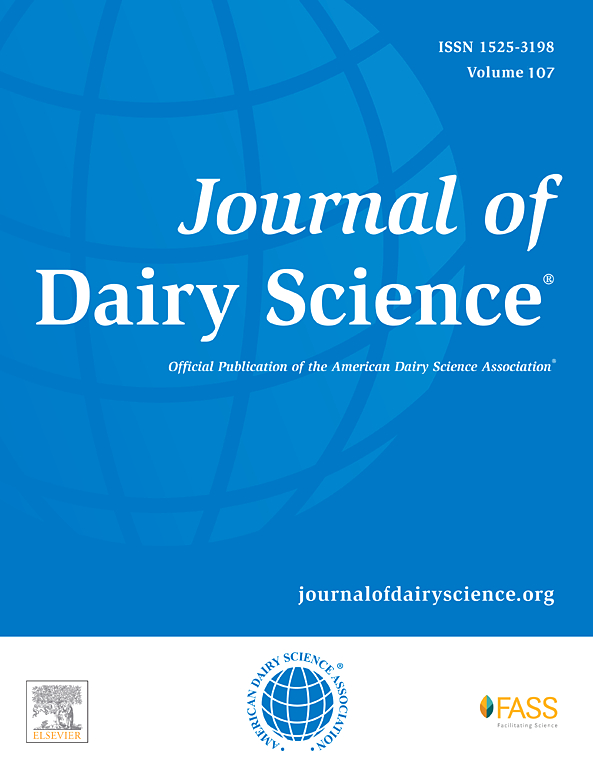体况评分、体况评分变化和高酮血症与乳腺炎、生殖和产奶量的关系
IF 4.4
1区 农林科学
Q1 AGRICULTURE, DAIRY & ANIMAL SCIENCE
引用次数: 0
摘要
身体状况评分(BCS)和高酮血症(HYK)与疾病、生育和淘汰有关,但它们与妊娠丢失的关系数据是矛盾的。我们的目的是进行一项回顾性队列研究,以调查BCS、BCS变化(ΔBCS)、血液β-羟基丁酸酯(BHB)和HYK与乳腺炎、妊娠/人工授精(P/AI)、妊娠丢失(PGL)、产奶量和密歇根州一个使用自动挤奶系统(AMS)的奶牛场离开牛群的风险之间的关系。我们记录了奶牛准备阶段(产犊前14 d)、产后阶段(14-21 DIM)的BCS,并评估了产牛在3 - 7 DIM之间的HYK。记录收集自牛群管理软件。评估BCS(孕前n = 826,产后n = 956) ΔBCS (n = 819)和BHB (n = 628)与乳腺炎、P/AI、PGL和离群风险的单变量关联。生存分析调查了胎次中BCS、ΔBCS和HYK与乳腺炎、妊娠和哺乳期离群危险的关系。我们使用重复测量混合模型检验了BCS、ΔBCS和HYK与全乳产奶量的关系。与BCS适中的牛群相比,BCS前(< 3.25)和产后(BCS < 2.75)较瘦的奶牛离开牛群的风险更高(OR分别为1.48和2.16)。产犊后BCS损失≥0.375单位的奶牛发生PGL的风险更高(OR = 4.99)。BCS损失≥0.75单位的奶牛被扑杀的风险更高(OR = 1.80)。患HYK的奶牛患乳腺炎的风险较高(RR = 1.34),被扑杀的风险较高(OR = 2.27)。BHB增加的奶牛患PGL和被淘汰的风险更高,BHB每增加1 mmol/L,风险分别增加2.32和1.67。3 +胎次高酮血症奶牛的泌乳产奶量比非hyk胎次低5.4 kg/d±1.04 kg/d(差值±SED)。我们的数据支持先前的研究结果,即BHB和HYK与乳腺炎、生育力、离群和产奶量有不良关联。我们的数据还表明,产犊后BCS丢失和哺乳期第1周的BHB是与PGL发病率相关的危险因素。本文章由计算机程序翻译,如有差异,请以英文原文为准。
Associations of body condition score, body condition score change, and hyperketonemia with mastitis, reproduction, and milk production
Body condition score and hyperketonemia (HYK) have been associated with diseases, fertility, and culling, but data are contradictory about their association with pregnancy loss. Our objective was to conduct a retrospective cohort study to investigate associations between BCS, BCS change (ΔBCS), blood BHB, and HYK with mastitis, pregnancy per artificial insemination (P/AI), pregnancy loss (PGL), milk yield, and risk of leaving the herd on a Michigan dairy farm that uses an automated milking system (AMS). We recorded BCS for cows prepartum (14 d before calving) and postpartum (14–21 DIM), and multiparous cows were evaluated for HYK between 3 and 7 DIM. Records were gathered from herd management software. Univariable associations of BCS (prepartum n = 826, postpartum n = 956) ΔBCS (n = 819), and BHB (n = 628) with mastitis, P/AI, PGL, and risk of leaving the herd were evaluated. Survival analyses investigated the association of BCS, ΔBCS, and HYK within parity with mastitis, pregnancy, and hazard of leaving the herd during lactation. We examined the association of BCS, ΔBCS, and HYK with whole lactation milk yield using repeated-measures mixed models. Thinner cows both pre- (BCS < 3.25) and postpartum (BCS < 2.75) had greater risk of leaving the herd (odds ratio [OR] = 1.48 and 2.16, respectively) compared with their moderate BCS herd mates. Cows who lost ≥0.375 units of BCS after calving had greater risk of PGL (OR = 4.99). Cows that lost ≥0.75 units of BCS had greater risk of being culled (OR = 1.80). Cows with HYK were at greater risk of mastitis (risk ratio = 1.34) and being culled (OR = 2.27). Cows with increasing BHB had greater risk of PGL and being culled such that a 1 mmol/L increase in BHB resulted in 2.32 and 1.67 greater risk, respectively. Hyperketonemic cows within third+ parity made 5.4 kg/d ± 1.04 kg/d (difference ± standard error of difference) less milk yield over their lactation compared with non-HYK third+ parity cows. Our data support previous findings that BHB and HYK had adverse associations with mastitis, fertility, leaving the herd, and milk yield. Our data also suggest that BCS loss after calving and BHB during wk 1 of lactation are risk factors associated with incidence of PGL.
求助全文
通过发布文献求助,成功后即可免费获取论文全文。
去求助
来源期刊

Journal of Dairy Science
农林科学-奶制品与动物科学
CiteScore
7.90
自引率
17.10%
发文量
784
审稿时长
4.2 months
期刊介绍:
The official journal of the American Dairy Science Association®, Journal of Dairy Science® (JDS) is the leading peer-reviewed general dairy research journal in the world. JDS readers represent education, industry, and government agencies in more than 70 countries with interests in biochemistry, breeding, economics, engineering, environment, food science, genetics, microbiology, nutrition, pathology, physiology, processing, public health, quality assurance, and sanitation.
 求助内容:
求助内容: 应助结果提醒方式:
应助结果提醒方式:


